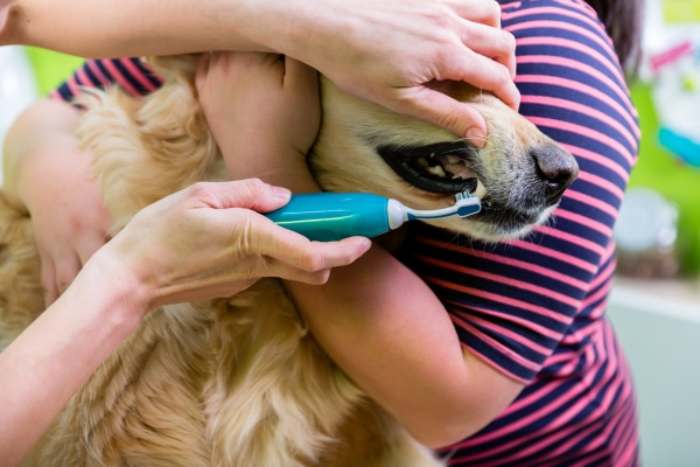Is Toothpaste Bad for Dogs? You might be surprised to learn that although toothpaste is beneficial for cleaning and maintaining a healthy mouth, it can also be dangerous.
This article will explore the benefits and risks of toothpaste for dogs, alternatives, and how toothpaste should be applied. Plus, we’ll hear from veterinarians about the best ways to keep your dog’s teeth clean and healthy.
Let’s dive in!
Benefits of Toothpaste: Recognizing the Positive Aspects of Canine Dental Care Products
Though you may not think so, toothpaste can benefit your pup if used correctly. When properly incorporated into your pup’s dental hygiene routine, toothpaste can help improve their oral health.
The mild abrasives in some toothpastes help to remove plaque and tartar buildup. Fluoride helps to strengthen the enamel on your pup’s teeth and prevent cavities. Additionally, some toothpastes contain ingredients that help to freshen breath and reduce bad odors.

However, it’s important to note that not all toothpastes are suitable for dogs. Research and consult your veterinarian to find the right toothpaste for your pup.
Risks of Toothpaste: Identifying Potential Hazards and Health Concerns for Dogs
You should know the potential risks of using toothpaste on your dog. Toothpaste toxicity is a major concern due to the presence of xylitol, a sugar alcohol often found in toothpaste. If ingested, xylitol can cause hypoglycemia, seizures, and even death.
Another risk is toothpaste contains chemicals and abrasives that can damage your pet’s teeth and gums if used too often or excessively. Also, using toothpaste formulated specifically for humans can harm your pet’s health. To ensure proper pet hygiene, always use pet-safe toothpaste recommended by your vet.
Toothpaste Alternatives: Exploring Safer Options for Maintaining Doggy Oral Health
If you’re looking for safer options, you can use several toothpaste alternatives on your pup. Instead of traditional toothpaste, consider a dental hygiene product specifically designed for pets.
Another option is to use a pet treat formulated to help clean a dog’s teeth and freshen breath. Additionally, several natural solutions can help with dental hygiene, such as baking soda, coconut oil, apple cider vinegar, and sea salt.
Please consult your veterinarian before using these alternatives to ensure they’re safe for your pup. With the right approach, you can keep your pup’s mouth clean and healthy without using traditional toothpaste.
Proper Techniques and Considerations for Safely Using Toothpaste:
Now that you know what alternatives to traditional toothpaste are available, it’s important to understand how to apply toothpaste to your pup properly.
Oral hygiene is essential for canine health, and a regular brushing routine can help to reduce bad breath. When applying toothpaste to your dog’s teeth, use a soft-bristled brush and a pea-sized amount.

Gently brush your pup’s teeth in a circular motion, avoiding their gums. Also, it’s important to rinse your dog’s mouth with lukewarm water after brushing to ensure the toothpaste is thoroughly removed.
Veterinary Advice: Seeking Professional Guidance on Canine Dental Care Products
Regularly brushing your pup’s teeth is important for oral hygiene, but it’s essential to ensure you’re using the right toothpaste. Veterinary advice is to use toothpaste that is specifically formulated for dogs. Dog-safe toothpaste is generally flavored and comes in various flavors appealing to canines.
| Brushing Techniques | Dental Hygiene | Toothpaste |
|---|---|---|
| Daily brushing | Clean teeth | Dog-safe |
| Use a soft brush | Remove plaque | Flavoured |
| Circular motion | Freshen breath | Appealing |
| Toothpaste & water | Tartar control |
Brushing techniques should be gentle, using a soft brush with circular motions. It’s important to use toothpaste and water while focusing on all the surfaces of the teeth. Doing so can help with tartar control, plaque removal, and freshening your pup’s breath.
Frequently Asked Questions:
No, toothpaste is not generally safe for puppies. While dogs need good dental care to prevent tooth decay, toothpaste designed specifically for puppies is best. Human toothpaste can contain ingredients that can be toxic to puppies, so it’s best to avoid it.
“You should use a toothpaste specifically designed for dogs. Consider dental chews and wipes to help keep your pup’s teeth clean. Metaphorically speaking, brushing your dog’s teeth is like giving them a healthy smile! It’s an important part of their health and well-being.”
Try alternative brushing methods for your dog, like finger brushes or gauze. These can provide dental health benefits without the need for toothpaste. There are many flavored toothpastes available that your pup might enjoy. Try out different flavors to find one they like!
Brush your dog’s teeth at least once a week for optimal dental health and oral hygiene. Use a toothpaste specifically designed for pets to ensure safety.
Yes, some herbal remedies and ingredients are safe for your dog. Natural toothpaste with herbal ingredients such as neem, aloe vera, and clove oil can help maintain your dog’s dental hygiene. Focus on finding quality ingredients for optimal dental health.
Conclusion:
When caring for your pup’s pearly whites, it’s important to consider the pros and cons of using toothpaste. In general, vets suggest using toothpaste that’s specifically designed for dogs.
Even then, it’s best to consult your veterinarian to decide what’s right for your pup. Ultimately, it’s important to remember that a dog’s health and well-being is the top priority – and that’s something to ‘chew’ on.

Hey there, I’m Janet Brooks, a dog-loving student from California. I’m all about helping pups in need, especially those without homes. Me and my awesome friends work together to give shelter and love to stray dogs. Oh, and I also write blogs about dogs to share helpful info.